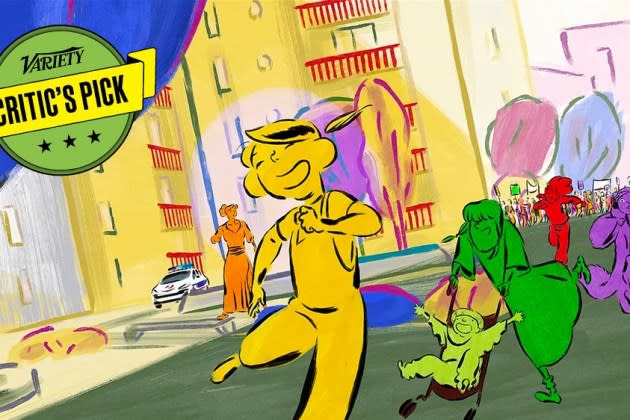‘Chicken for Linda!’ Review: Gorgeous French Toon Gets Mother-Daughter Bonds Better Than Most Live-Action Movies
- Oops!Something went wrong.Please try again later.

Lately, in the overwrought majority of Hollywood blockbusters, nothing less than the fate of the planet hangs in the balance, as some natural disaster or dastardly supervillain threatens to annihilate life as we know it. Such impossibly large stakes may be necessary to justify the CG spectacle of certain Marvel movies, but instead of inspiring excitement, they mostly leave me ambivalent and bored. But focus in on something as simple as whether a young girl can have the chicken dish that reminds her of her late dad, and I’m riveted. Bonus points if said cartoon feels more realistic than most live-action fare.
A uniquely styled and all-around delightful hand-drawn family drama, “Chicken for Linda!” premiered at this year’s Cannes Film Festival, programmed practically out of sight in the ACID, a sidebar dedicated to low-budget independent productions that’s easily overlooked (despite having launched the career of “Anatomy of a Fall” director Justine Triet). I passed right over “Chicken for Linda!” at Cannes, prioritizing higher-profile titles, then caught up with the movie a few weeks later at the Annecy Animation Festival, where it earned the top prize. In retrospect, I wouldn’t hesitate to call “Chicken for Linda!” the best film of Cannes this year.
More from Variety
In this modest masterwork, husband-and-wife animation team Sébastien Laudenbach and Chiara Malta shrewdly use their clucking MacGuffin as a chance to explore the dynamic between a widowed young mother (voiced by Clotilde Hesme) and the 8-year-old daughter (Mélinée Leclerc) still learning to grieve a father figure she can hardly remember. The co-directors convey this tragedy with an inventive sense of restraint over the film’s opening credits: Linda’s dad simply disappears from the frame — a bright red bubble fading from the constellation of memories she clings to from those first years of life.
All of the characters are color-coded in a film that looks and feels like the Sunday funny pages come to life, erupting with expressionistic bursts of yellow (Linda), orange (her mom), purple (their plump cat, Gazza) and blue. In the film’s keenly observed early scenes, Linda’s mom, Paulette, falsely accuses her daughter of stealing a green ring that holds special sentimental value. When she discovers her mistake, Paulette asks the girl what she can do to make up for it. Linda wants chicken, or more precisely, she wants Paulette to make her Italian dad’s signature chicken dish — a reasonable enough request that proves surprisingly difficult to pull off, and whose underlying emotional motivation grows steadily more significant as the film goes along.
Malta and Laudenbach have crafted an entertaining, kid-friendly toon whose power lies less in its plot than the surprising insights into human behavior revealed along the way. It’s all the more impressive that animation (as opposed to live action) succeeds in capturing the kind of gestures and details that should seem familiar to any child, from the distorted blur of street lights observed from the back seat to a lesson Linda’s aunt gives in shelling peas.
As in Laudenbach’s earlier feature, “The Girls Without Hands” (based on a lesser-known Grimm story), the film relies on broad black brushstrokes and loose daubs of color that bleed beyond the lines. It’s a bold, original style one might expect to come across in an animated short film (where the artist’s touch tends to be encouraged), or else used to illustrate a children’s picture book (like “Harold and the Purple Crayon,” perhaps). To find it applied at feature length — with what must have been painstaking effort — is a most delightful surprise.
In a distinctly French detail, Linda demands chicken at precisely the moment her entire neighborhood goes on strike. That means the grocery stores are closed and the people are out protesting, forcing Paulette to get creative about where to find a spare bird. She winds up stealing one from the local farm, setting off a chain of events sure to amuse young viewers more than their parents: a police stop, a bicycle chase, a rowdy scene in which all the neighborhood kids try to coax the runaway chicken out of a tree. That said, adults will appreciate the attention the filmmakers have paid to the personalities of their main characters.
Linda’s a handful. Paulette looks and sounds like an exasperated parent (even before the filmmakers give her a lullaby to sing about the relief all tired moms and dads crave), while older sister Astrid (Laetitia Dosch) seems to have it all figured out until her own song comes along. These musical numbers, written by Clément Ducol, spice up an outside-the-box toon that’s constantly tickling audiences with unexpected ingredients — like the watermelon free-for-all in the parking lot beneath Linda’s apartment. The movie feels spontaneous and unpredictable, like its protagonist, whom no one could fault for craving human connection and a way to process her loss. Who’d have thought the recipe for both might be so sweet?
Best of Variety
Sign up for Variety’s Newsletter. For the latest news, follow us on Facebook, Twitter, and Instagram.
